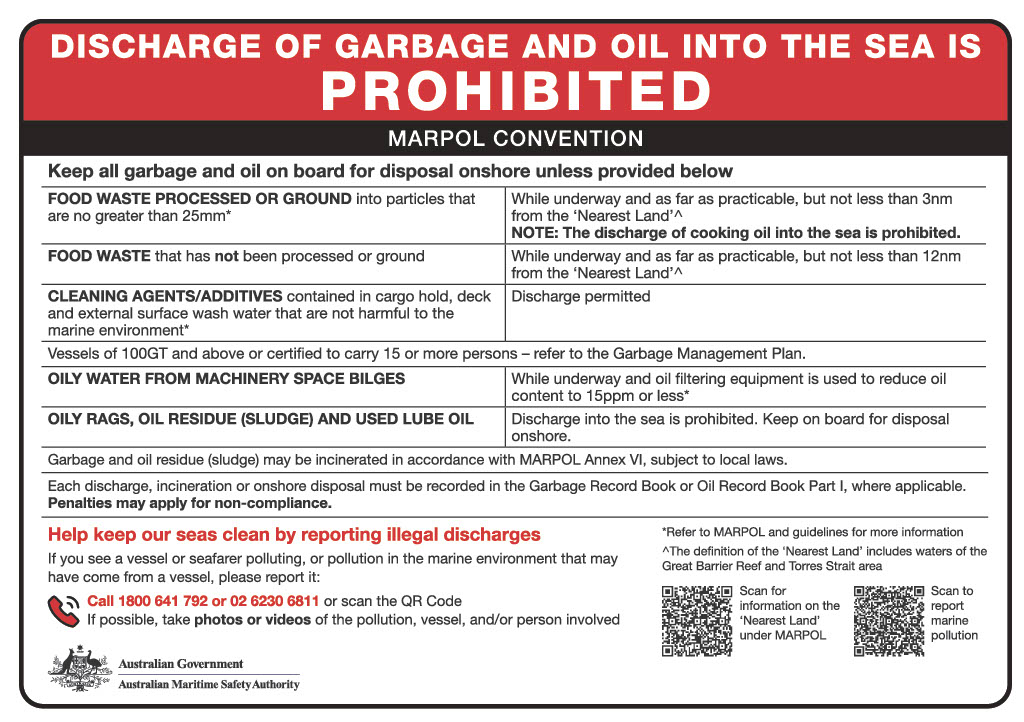We want to protect the marine environment from pollution for all Australians. Our laws reinforce this commitment.
The International Convention for the Prevention of Pollution from Ships (MARPOL) Annex V (MARPOL Annex V) deals with garbage. It prohibits the discharge of garbage into the sea.
The regulations apply to all vessels operating in the marine environment. This includes all DCVs, from commuter ferries and work boats to small tinnies and fishing trawlers.
Use the resources in this section to make sure you comply and help keep our seas clean.
Garbage guide
The regulations prohibit the disposal of all garbage into the sea, except in limited circumstances.
Under MARPOL Annex V, garbage includes:
- all kinds of food wastes
- domestic and operational wastes
- all plastics
- cargo residues
- incinerator ashes
- cooking oil
- fishing gear
- animal carcasses
- e-waste.
Prohibited discharges
| Location | Garbage discharge prohibition |
|---|---|
| Within 3 nautical miles from the nearest land | All garbage discharge is prohibited, which includes the Great Barrier Reef (GBR) area and waters to 3 nautical miles from its outside boundary. |
| Outside 3 nautical miles from the nearest land and the GBR outer boundary | All garbage is prohibited, except food wastes processed to less than 25mm. |
| Outside 12 nautical miles from the nearest land and the GBR outer boundary | All garbage is prohibited, except unprocessed food wastes. |
Note: Discharge of cooking oil into the sea is prohibited.
There are also a couple of exceptions to the regulations, including accidentally discharging garbage as a result of damage. See Exceptions and penalties to understand when these apply.
How to manage your garbage
Preventing garbage pollution requires good management, record keeping and signage.
1. Create a garbage management plan
Required for vessels either:
- certified to carry 15 or more people
- 100 gross tonnage or above.
Note: If your vessel is about 24 metres or more in measured length, it may exceed 100 gross tonnage. Check the NSCV Part B-General Requirements, Clause 3.5 Determination of Vessel Gross Tonnage to calculate.
The garbage management plan lists how you manage, collect, store, process and dispose of garbage.
Learn what to include in your plan and see an example.
2. Use a garbage record book
Learn which vessels are required to use a garbage record book.
From 1 May 2024, Australian vessels of 100 gross tonnage and above on an overseas voyage will be required to maintain a garbage record book in addition to a garbage management plan.
You can buy a garbage record book or print one for free.
3. Use the right signage
If your vessel is 12 metres or more in length, you must display a MARPOL placard.
Different versions are available for all vessel types and sizes, including DCVs. Order these signs from us (for free) and display where crew and passengers will see them. For example:
- in galley spaces
- on the bridge
- on the main deck
- in passenger spaces and accommodation (if any).
This sign summarises the rules for the discharge of garbage.

A ‘Stow it, don’t throw it’ sticker is also available.
Garbage reception facilities
All ports, marinas and boat harbours must provide facilities to receive garbage generated on board vessels.
Sort and separate all the waste on board your vessel, so each type can be recycled or disposed of appropriately on shore.
Contact your local marina, boat harbour, port or terminal office to find out what garbage collection and disposal facilities are available. If the facilities you need are not there, let them know. You can also reach out to your local council or state maritime safety agency to report this.
Help protect our marine environment and report illegal garbage discharge.
More information
Use these resources if you need more detailed information on garbage management.
- Marine Notice 01/2022 MARPOL Annex V (Garbage) discharges – details Australia’s implementation of MARPOL Annex V
- Discharge standards – provides a summary of the standards under MARPOL for Australian waters
- 2017 Guidelines for the Implementation of MARPOL Annex V (Resolution MEPC.295(71)). These guidelines provide information on all aspects of garbage management
- Managing Solid Bulk Cargo Residues in Australian Waters
- Revisions to MARPOL - Current texts